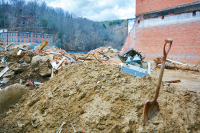Solar in the Smokies: Duke proposes microgrid for Mt. Sterling

Utility companies are not often known for being in harmony with nature; indeed, Duke Energy’s recent coal ash fiascos come readily to mind when environmental and industrial concerns begin to comingle.
But Duke’s looking to change all that with the installation of a futuristic, environmentally friendly microgrid on Mt. Sterling that will allow 4 miles of utility right-of-way — power poles and wires within The Great Smoky Mountains National Park — to revert back to nature.
“It’s one of those where existing infrastructure has about a couple dozen power poles going up the mountain to serve that communications tower up there. It’s the only customer on that line,” said Duke Energy Spokesman Randy Wheeless.
The communications tower he’s referring to sits 5,800 feet above sea level and serves the park’s emergency radio network. Currently, a downed line or broken pole would render it worthless.
The proposed panel array and battery setup designed to remove it from the electrical grid would not only provide more self-sufficiency for the tower in a sustainable way, but also reduce maintenance costs and increase safety.
“It’s a great way of introducing this technology into a real-life situation,” Wheeless said. “We’ve been doing a lot of work with microgrids and battery and solar storage, and it made perfect sense to try here with all the experience we’ve had with the technology.”
Related Items
That experience includes two existing microgrids — one at a Duke research facility in Gaston County that helps power the facility itself and one at Charlotte Fire Station 24.
“The one in Charlotte serves as a backup to a fire station that is next door to the solar and the battery,” he said. “It has worked very well, perfectly the past few years. There were times that it looked like the station was going to lose power, but it never did.”
Each panel is about 4 feet by 3 feet in size. According to Wheeless, the Mt. Sterling project will probably require a few dozen.
“There definitely is a level landing up there where the tower is that will have plenty of space for the solar and the battery,” he said.
The battery is made in the U.S., as are some of the panels.
“We’ve been roughly half and half,” he said. “There’s a lot made in America but there’s a lot made in, like, Singapore, or the far East.”
The microgrid system is designed to provide 10 kilowatts of power to the tower, which is about twice what a typical house might need.
“The battery could run and serve the tower for a few days if there was no sun whatsoever,” Wheeless said. “It could probably power a house in much of the same way, but the tower doesn’t use much energy. We don’t think we should have a problem meeting those needs, even if it’s cloudy for several days.”
Wheeless said that outside of heating or cooling seasons — when central climate control systems hog power — the Mt. Sterling setup could power a house for “maybe a few days.”
Aside from the reliability factor, Duke also stands to realize a substantial cost savings on line maintenance to the tower.
“When you are replacing those poles or a pole breaks, usually you have to bring in a helicopter, in that terrain,” he said. “The rental on a helicopter for a day, it’s pretty expensive. And that’s just for one pole.”
Winter storms and other inclement weather on the mountain can result in numerous poles becoming compromised and needing to be replaced all at once, in addition to the natural attrition of the poles.
“It’s hard to say ‘we’re going to save a million dollars a year,’ but over a period of time — and this project has a shelf life of 20 years or so — we think over time it will more than pay for whatever we’re investing in it today.”
Duke hasn’t released the cost of the project, but it’s estimated to be under $1 million. The company hopes to begin work in the first half of 2017, once the lengthy permitting process has concluded.
“I know we have the National Park Service,” he said, referring to their project requirements, “but also the North Carolina Utilities Commission. But from the Utilities Commission standpoint, it’s a relatively small project.”
Wheeless said he didn’t anticipate any hang-ups in the process, and is eager to begin reaping the benefits of the Mt. Sterling microgrid.
“Once we get it built, we’ll test it for a number of months to make sure everything’s working correctly and then eventually we’ll be able to take down some of those poles that are serving that tower,” he said. “Hopefully, most people will see the benefits of the project — it’s giving land back to the park service and hikers, and it’s still going to save our customers to do it this way, and still give them their reliable service with the tower.”









